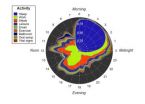(Press-News.org) DALLAS -- A protein that controls when genes are switched on or off plays a key role in specific areas of the brain to regulate metabolism, UT Southwestern Medical Center researchers have found.
The research potentially could lead to new therapies to treat obesity and diabetes, since the transcription factor involved – spliced X-box binding protein 1 (Xbp1s) – appears to influence the body's sensitivity to insulin and leptin signaling. Insulin and leptin are hormones central to the body's regulation of food intake and sugar disposal, and obesity and diabetes are conditions under which the body develops resistance to their actions.
"This study identifies critical molecular mechanisms that link the brain and peripheral endocrine tissues and that ultimately contribute to the regulation of body weight and glucose metabolism," said Dr. Kevin Williams, Assistant Professor of Internal Medicine and co-first author of the study with Dr. Tiemin Liu, a postdoctoral research fellow in Internal Medicine.
Researchers found that over-expression of the gene Xbp1s in mice that were fed a high-fat diet protected them against obesity and diabetes, according to the recent study, published online in Cell Metabolism. On average, these mice were 30 percent leaner than mice fed the same food.
The gene's actions took place in pro-opiomelanocortin (Pomc) neurons in the hypothalamic region of the brain. Elevated Xbp1s levels in Pomc neurons mimicked a "fed" signal, resulting in improved body weight, decreased blood glucose levels, and improved insulin sensitivity in the liver.
"Manipulating this one gene in the brain affected metabolism in the liver. This result shows that the brain is controlling glucose production by the liver," said Dr. Joel Elmquist, Director of the Division of Hypothalamic Research, Professor of Internal Medicine, Pharmacology, and Psychiatry, and holder of the Carl H. Westcott Distinguished Chair in Medical Research, and the Maclin Family Distinguished Professorship in Medical Science, in Honor of Dr. Roy A. Brinkley.
Dr. Elmquist was co-senior author of the study, along with Dr. Philipp Scherer, Director of the Touchstone Center for Diabetes Research, Professor of Internal Medicine and Cell Biology, and holder of the Gifford O. Touchstone, Jr. and Randolph G. Touchstone Distinguished Chair in Diabetes Research.
No drug form of Xbp1s currently exists that could be used to test whether the gene is a target for the treatment of diabetes or obesity, though researchers see such a drug as a potential outgrowth of their research. Dr. Williams said other transcription factors involved in the same metabolic pathway will be studied to see if they have similar effects.
"We have studied one transcription factor out of many that participate in a large, complex cellular process," said Dr. Williams of Xbp1s and its role during times of cellular stress.
INFORMATION:
Other UT Southwestern researchers contributing to this study were co-first author Dr. Makoto Fukuda, a former postdoctoral researcher in Internal Medicine; Dr. Yingfeng Deng, Assistant Instructor of Internal Medicine; Dr. Eric Berglund, Assistant Professor of Pharmacology and part of the Advanced Imaging Research Center; Dr. Jong-Woo Sohn, former postdoctoral researcher in Internal Medicine; Dr. Lin Jia, a postdoctoral researcher in Internal Medicine; Dr. Teppei Fujikawa, Instructor of Internal Medicine; Dr. Daisuke Kohno, former postdoctoral researcher in Internal Medicine; Dr. Syann Lee, Instructor of Internal Medicine; Charlotte Lee, a senior research scientist in Internal Medicine; and Dr. Kai Sun, Instructor of Internal Medicine.
The study was supported by grants from the National Institutes of Health, American Diabetes Association, American Heart Association, and the Juvenile Diabetes Research Foundation.
About UT Southwestern Medical Center
UT Southwestern, one of the premier academic medical centers in the nation, integrates pioneering biomedical research with exceptional clinical care and education. The institution's faculty includes many distinguished members, including six who have been awarded Nobel Prizes since 1985. Numbering more than 2,700, the faculty is responsible for groundbreaking medical advances and is committed to translating science-driven research quickly to new clinical treatments. UT Southwestern physicians provide medical care in 40 specialties to nearly 91,000 hospitalized patients and oversee more than 2 million outpatient visits a year.
Manipulating key protein in the brain holds potential against obesity and diabetes
2014-07-25
ELSE PRESS RELEASES FROM THIS DATE:
Why do men prefer nice women?: Responsiveness and desire
2014-07-25
People's emotional reactions and desires in initial romantic encounters determine the fate of a potential relationship. Responsiveness may be one of those initial "sparks" necessary to fuel sexual desire and land a second date. However, it may not be a desirable trait for both men and women on a first date. Does responsiveness increase sexual desire in the other person? Do men perceive responsive women as more attractive, and does the same hold true for women's perceptions of men? A study published in Personality and Social Psychology Bulletin seeks to answer those questions. ...
ACR statement on cancer study regarding patient anxiety from CT lung cancer screening
2014-07-25
Anxiety regarding inconclusive cancer screening test results among some patients is real and is only natural. However, as evidenced by Gareen et al, published July 25 in Cancer, the incidence and effects of anxiety associated with false positive or other results of computed tomography (CT) lung cancer screening exams are far less than claimed by some in the medical community.
"Unsubstantiated claims of systemic and harmful patient anxiety should now be put to rest and not continue to delay implementation of CT lung cancer screening programs or Medicare coverage for these ...
Vanderbilt study examines bacteria's ability to fight obesity
2014-07-25
A probiotic that prevents obesity could be on the horizon. Bacteria that produce a therapeutic compound in the gut inhibit weight gain, insulin resistance and other adverse effects of a high-fat diet in mice, Vanderbilt University investigators have discovered.
"Of course it's hard to speculate from mouse to human," said senior investigator Sean Davies, Ph.D., assistant professor of Pharmacology. "But essentially, we've prevented most of the negative consequences of obesity in mice, even though they're eating a high-fat diet."
Regulatory issues must be addressed before ...
NSU researcher part of team studying ways to better predict intensity of hurricanes
2014-07-25
FORT LAUDERDALE-DAVIE, Fla. – They are something we take very seriously in Florida – hurricanes. The names roll off the tongue like a list of villains – Andrew, Charlie, Frances and Wilma.
In the past 25 years or so, experts have gradually been improving prediction of the course a storm may take. This is thanks to tremendous advancements in computer and satellite technology. While we still have the "cone of uncertainty" we've become familiar with watching television weather reports, today's models are more accurate than they used to be.
The one area, however, where ...
NASA maps Typhoon Matmo's Taiwan deluge
2014-07-25
When Typhoon Matmo crossed over the island nation of Taiwan it left tremendous amounts of rainfall in its wake. NASA used data from the TRMM satellite to calculate just how much rain fell over the nation.
The Tropical Rainfall Measuring Mission or TRMM satellite orbits the Earth and provides coverage over the tropics. TRMM is a satellite that is managed by both NASA and the Japan Aerospace Exploration Agency (JAXA) that acts as a "flying rain gauge in space," that can estimate how fast rain is falling within storms on Earth and how much rain has fallen.
On July 22, ...
Shift work linked to heightened risk of type 2 diabetes
2014-07-25
Shift work is linked to a heightened risk of developing type 2 diabetes, with the risk seemingly greatest among men and those working rotating shift patterns, indicates an analysis of the available evidence published online in Occupational & Environmental Medicine.
Previous research has suggested links between working shifts and a heightened risk of various health problems, including digestive disorders, certain cancers, and cardiovascular disease. But whether diabetes can be added to the list has not been clear.
The authors therefore trawled through scientific research ...
Smartphone experiment tracks whether our life story is written in our gut bacteria
2014-07-25
Life events such as visiting another country or contracting a disease cause a significant shift in the make-up of the gut microbiota – the community of bacteria living in the digestive system, according to research published in the open access journal Genome Biology.
Two participants used smartphone apps to collect information every day for a year in the study by scientists from MIT and Harvard. The authors think the method could be rolled out to studies of human-bacteria relationships with many more participants.
Our microbiota is the community of bacteria that share ...
Leaf-mining insects destroyed with the dinosaurs, others quickly appeared
2014-07-25
After the asteroid impact at the end of the Cretaceous period that triggered the dinosaurs' extinction and ushered in the Paleocene, leaf-mining insects in the western United States completely disappeared. Only a million years later, at Mexican Hat, in southeastern Montana, fossil leaves show diverse leaf-mining traces from new insects that were not present during the Cretaceous, according to paleontologists.
"Our results indicate both that leaf-mining diversity at Mexican Hat is even higher than previously recognized, and equally importantly, that none of the Mexican ...
Monitoring the rise and fall of the microbiome
2014-07-25
CAMBRIDGE, MA -- Trillions of bacteria live in each person's digestive tract. Scientists believe that some of these bacteria help digest food and stave off harmful infections, but their role in human health is not well understood.
To help shed light on the role of these bacteria, a team of researchers led by MIT associate professor Eric Alm recently tracked fluctuations in the bacterial populations of two research subjects over a full year. The findings, described in the July 25 issue of the journal Genome Biology, suggest that while these populations are fairly stable, ...
Atomic structure of key muscle component revealed in Penn study
2014-07-25
VIDEO:
This is a representation of the atomic structure of tropomodulin at the minus end of the actin filament in muscle sarcomeres. Tropomodulin interacts with the first three actin subunits of...
Click here for more information.
PHILADELPHIA - Actin is the most abundant protein in the body, and when you look more closely at its fundamental role in life, it's easy to see why. It is the basis of most movement in the body, and all cells and components within them have the capacity ...



